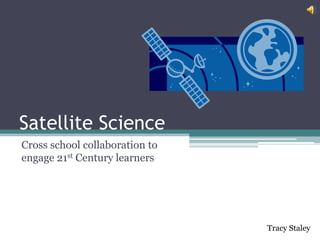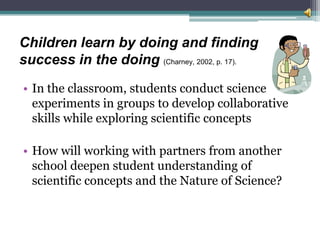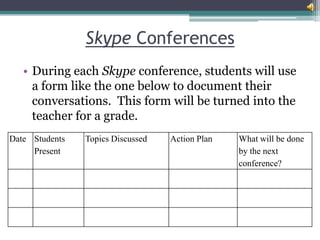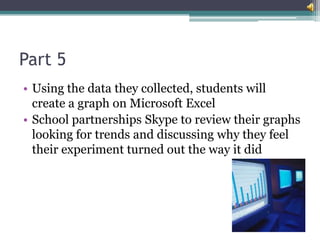Staley satellite science
- 1. Satellite Science Cross school collaboration to engage 21st Century learners Tracy Staley
- 2. Children learn by doing and finding success in the doing (Charney, 2002, p. 17). • In the classroom, students conduct science experiments in groups to develop collaborative skills while exploring scientific concepts • How will working with partners from another school deepen student understanding of scientific concepts and the Nature of Science?
- 3. • The following lessons will: ▫ Allow students to explore Physical Science concepts as well as the Nature of Science ▫ Provide opportunities for collaboration within and beyond the school walls ▫ Strengthen verbal, written and media literacy through the use of various methods including video conferencing and blogs
- 4. Websites/Software Used • www.kidblog.com • Skype • Microsoft Excel • Google custom search engine • Microsoft Movie Maker • Photo software • Screen capture software
- 5. Cross School Collaboration • I will be working with a colleague at Madeira Beach Elementary School in Pinellas County • Our students will work collaboratively to complete this project
- 6. Part 1 • Display a list of physical science topics: Electricity, Gravity, Friction, Motion, Sound Energy, Light Energy, Thermal Energy, Matter, Physical & Chemical changes, etc. • On a scratch piece of paper, have students list their top 3 choices for further exploration • Place students into partnerships based on interest • Allow partnerships to research information about their topic using a teacher created search engine http://www.google.com/cse/home?cx=0046667053085 99471608:9ribgz-q4v4 • Inform students the purpose of their research is to come up with a list of 5-7 questions they have about their topic
- 7. Story Planning Guide How did you decide which question you would explore? How will you show this to the audience? What materials will you need to conduct your experiment? How will you show this to the audience? How will you show the audience how to follow your directions? How will you document your experiment? Who will conduct the experiment? Who will take the photos/video? How did you analyze your data? What did you learn? How will you show this to the audience? Distribute the Digital Story Planning Guide Did you experiment turn out like your cross school partner’s? (right) Why do you think your experiment turned out the way it did? How will you show this to the audience? Students will use this guide throughout the project to document their work What did you learn by working with students from another school? How will you show this to the audience?
- 8. Blog #1 What topic are you and you partner interested in studying? List 2-4 questions you have about your project.
- 9. Cross School Collaboration • At the end of the day, I will video conference with my colleague to review our partnerships • We will create groups of four by blending partnerships from each school
- 10. Part 2 • Using Skype, the teachers will introduce students to their cross county partners • The teachers will remind students how to use Skype, then send partnerships off for their first team Skype conference • During this conference, students will share their list of questions and narrow down the list to the top 3 experiments they would like to conduct • The group must present their experiment ideas to the teacher for approval before moving on
- 11. Skype Conferences • During each Skype conference, students will use a form like the one below to document their conversations. This form will be turned into the teacher for a grade. Date Students Topics Discussed Action Plan What will be done Present by the next conference?
- 12. Cross School Collaboration • Teachers will review then approve experiment ideas for groups • Students needing assistance selecting an experiment will have a conference with their teacher
- 13. Part 3 • Students will continue to have Skype conferences to: ▫ Share ideas ▫ Create a materials list ▫ Write directions for completing their experiment
- 14. Blog #2 What materials will you need to complete your experiment? Compile your list then visit at least 2 other classmates’ blogs. Read over their materials list and comment on whether or not they have forgotten anything. #3 List the directions to complete your experiment. Remember to use metric measurements and to start each sentence with a verb. After completing your list, visit at least 2 other group’s blogs and review their directions. Did they forget something? Let them know!
- 15. Part 4 • Using the directions created by the team, school partnerships will conduct their experiments, documenting their work using still or video cameras • Students will use Microsoft Excel to collect the data they collect
- 16. Part 5 • Using the data they collected, students will create a graph on Microsoft Excel • School partnerships Skype to review their graphs looking for trends and discussing why they feel their experiment turned out the way it did
- 17. Blog #4 Compile your data using Microsoft Excel and use the data to create a graph. Take a screen capture of your graph and post it on your blog so your partners at Madeira Beach can see your results. Then, compare your graph to theirs. What is similar? Different? Explain your thinking.
- 18. Part 6 • School partnerships will use their Digital Story Planning Guide to create a storyboard for their digital story • Partnerships will select and import the images they will use into Microsoft Movie maker, record their voice-over and add any text, screen shots, music etcetera to their digital story
- 19. Part 7 • Students will share their learnings with their schoolmates by presenting their digital stories • After viewing the class’s projects, the teacher will lead students in a discussion about what they have learned through this process ▫ Discussion should focus on the results of their experiments ▫ If students completed their experiments correctly, their results should mirror those of their cross school partners. If they do not, something was not done correctly. This is a Nature of Science concept students struggle with, therefore seeing multiple groups attain similar results should reinforce this concept
- 20. Blog #5 What did you learn by working with scientists from another school? Did you enjoy this experience? Why or why not?
- 21. Sample Experiment Digital Story • Below you will find a link to a VoiceThread created by Heather Sullivan • Ms. Sullivan is a teacher who uses VoiceThread for her student’s lab reports • This is an example of what how students can document their learning using multimedia tools • http://voicethread.com/?#q.b167884.i893744
- 22. Contact Me Tracy Staley 5th Grade Math/Science Ponce de Leon Elementary staleyt@pcsb.org References: Charney, Ruth, S. (2002). Teaching children to care: Classroom management for ethical and academic growth, K-8. Greenfield, MA: Northeast Foundation for Children.
Editor's Notes
- As a science teacher, I have seen the benefit of providing hands-on, collaborative learning experiences for my students. My exploration of Convergence Culture has led me to ponder how cross school collaboration may deepen learning for my students. So I developed a series of lessons to complete with my class.
- Teachers wanting to use these lessons will need internet access as well as access to the software programs listed above. Some of these programs may not be available at your school. Search the web. There are several similar programs which are free and may work in your school setting.
- This project requires collaboration with at least one teacher from another school. I will be working with another 5th grade teacher at Madeira Beach Elementary school in Pinellas County. We have a strong working relationship and currently virtually collaborate on lesson plans. It is important you find someone who is willing to put forth a little extra effort and time to make this project work.
- The first step is helping your students narrow their focus on a topic of interest. I will display a list of topics covered for students to review. I compiled this list using the 5th grade Physical Science benchmarks. Remember that although this lesson was created for Physical Science but can be easily adapted for any of the sciences. I do not allow talking during this time because I want my students to choose a topic that interests them, not because it’s what their friend chose. After students list their top 3 choices, I will partner them up with a student who is interested in the same topic. Then the partnerships will explore their topic using a search engine I created using Google Custom search engines to ensure the information students find is grade level appropriate. As students are researching, they are to develop a list of questions about their topic they wish to further explore.
- This planning guide should be distributed to students before they start researching. It should be used throughout this project as it will become very important at the end of their project when they have to share their learnings. Refer to it often and ensure students are completing it as they go.
- After researching with their partners, students will complete their 1st blog entry. I use KidBlog, a website created for teachers. It is an easy to use website which allows you to moderate conversations while encouraging collaborations. My students absolutely love the site and enjoy the opportunity to share their thinking in this way. Students at both schools will be able to see and comment on each other’s blogs. This 1st entry will allow students to discuss the process of determining a topic and working with their partner, while giving me a sneak peak at their project ideas.
- After partnering students up, I will Skype with my partner at Maderia Beach to review our partnerships and match students up with partners from the other school
- For the next lesson, I will Skype with my partner at Madeira Beach. This will be a great time to review Skype with my students and remind them how things work. If your students are new to Skype, you may want to have additional lessons in this area. During this conversation, my students will be introduced to their partners at Madeira Beach. Then I will send them off to Skype on their own. During their 1st conference, students will share their project ideas and create a list of 3 experiments they would like to conduct. I have them list 3 just in case one of their ideas doesn’t work or doesn’t fit the curriculum.
- On a side note, students will be provided with a form to help them document their Skype conferences. This form will help me to determine participation as well as help guide students as the have their conferences.
- Once again, I will work with my teaching partner to approve experiment ideas or determine if certain groups need additional teacher support.
- Over the next few days, students will have conferences to share ideas, determine the materials they will need to conduct their experiment and write the directions for their experiment.
- After conferencing, students will blog to reflect on their work thus far. In addition to helping students reflect, blog entries will be quite useful when students work on their final presentations.
- Once the directions have been written, school partnerships will conduct their experiments. I will have students use Microsoft Excel to collect their data. Excel allows students to easily convert their data table into a graph, creating a tool for data analysis.
- During this part of the lesson, students will be reviewing their graphs and sharing them with their cross school partners. During this conference, student conversation should be focused on similarities and differences in their results as well as why they believe their experiment turned out the way it did.
- Once again, students will blog about their project, particularly their data collection. Students will post a screen capture of their graph onto their blog allowing their partners at the other school to compare the data. The goal is for students to see that although the conducted their experiments in different locations, the results are similar if not the same
- Using the Digital Story Planning Guide given to them at the beginning of this project, students will create a digital story to document their experience. If you have not created Digital Stories with your students, you will want to spend time before this project helping them learn how to use the appropriate software, create storyboards, write scripts, etc. There are several resources available online to those who are interested in using digital stories in the classroom. My students will work with their in-class partner to create their digital story.
- Students will share their digital stories with their classmates. After viewing the stories, I will guide students in a discussion about the results of their experiments. Students struggle with understanding the importance of writing explicit directions and following them precisely and how this helps scientists learn. By allowing students to see students in an entirely different location had similar results, I hope to reinforce this Nature of Science phenomena. If students have different results, I will focus the conversation on why they feel that happened, hoping they will realize that small changes can have a big impact on experiment results.
- For a final reflection, students will blog about their experience working with students from another school. This will be the first time I use a learning experience like this and I am interested in their feedback.
- To wrap things up, I have included a link to a VoiceThread presentation created by a teacher named Heather Sullivan. She uses VoiceThread as a way for students to share their lab reports. This is similar to what I would like to do with my students, but not exactly.
- After implementing this project, I will be happy to share student projects with you. Please feel free to contact me if you are interested in seeing my student samples or if you have any questions or comments!





















